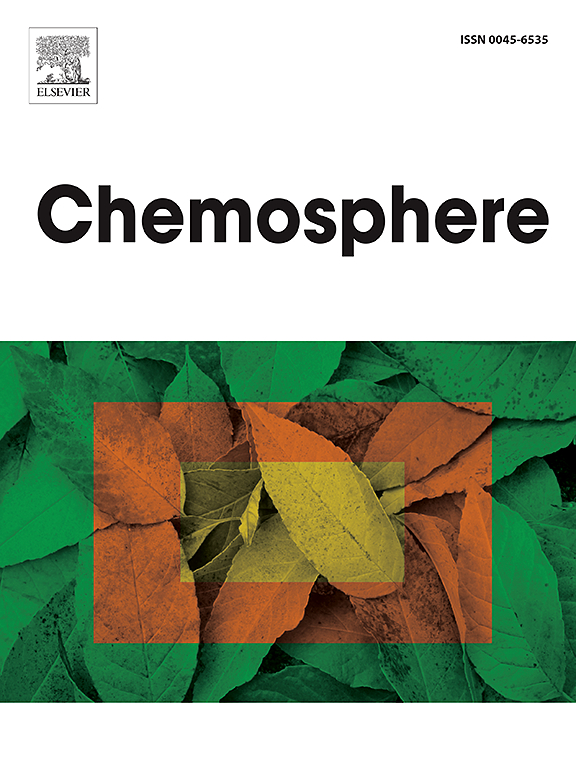Mechanisms of interactions and the significance of different colloidal structures in the vertical transport of glyphosate in soils with contrasting mineralogies
IF 8.1
2区 环境科学与生态学
Q1 ENVIRONMENTAL SCIENCES
引用次数: 0
Abstract
Soil is regarded as a natural repository for strongly adsorbed pollutants since glyphosate (GLY) is preferentially adsorbed by the inorganic fraction of the soil, which may greatly limits its leaching. In this way, understanding how clay mineralogy influences the sorption and transport processes of glyphosate in soils with different mineralogical characteristics is highly relevant. In this work, two clay mineralogy contrasting soils were used to evaluate GLY retention: a Oxisol (OX) with high levels of iron oxides (amorphous and crystalline) and a Inceptisol (IN) with a predominance of kaolinite. According to results obtained, the sorption process is influenced by more than one mechanism, including intraparticle diffusion, which is particularly favored at pH 4.00, and mass transfer across the boundary layer, which is favored at pH 6.50. When evaluating the adsorption isotherms, some differences associated with pH were also observed. At pH 4.00, good fits were obtained with the Freundlich model, suggesting electrostatic interaction between the compound and the soil. At pH 6.50, the best modeling involves the Langmuir-Freundlich model, indicating the occurrence of chemical and physical interactions. Desorption studies suggest that GLY sorption at pH 4.00 mostly involves the formation of inner-sphere complexes, while at pH 6.50, much of the sorption involves outer-sphere complexes. In column studies, GLY leaching was observed in both soils at concentrations between 0.01 and 0.02 mg L−1. After pH correction by liming, differences were observed in the leached GLY concentration, especially in the second rain event in, which leached concentrations greater than 0.04 mg L−1. These results confirm the strong sorption of GLY in the soil, as well as its evident mobilization through the soil column, probably due to colloid-facilitated transport.

不同胶体结构在不同矿物学土壤中草甘膦垂直运移中的相互作用机制及意义。
土壤被认为是强吸附污染物的天然储存库,因为草甘膦(GLY)优先被土壤的无机部分吸附,这可能极大地限制了其淋滤。因此,了解粘土矿物学如何影响草甘膦在不同矿物学特征土壤中的吸附和运输过程具有重要意义。在这项工作中,两种粘土矿物学对比土壤被用来评估GLY保留:氧化铁(无定形和结晶)含量高的Oxisol (OX)和高岭石为主的Inceptisol (In)。结果表明,吸附过程受到多种机制的影响,包括在pH为4.00时特别有利于颗粒内扩散,以及在pH为6.50时更有利于边界层的传质。在评价吸附等温线时,还观察到一些与pH有关的差异。当pH值为4.00时,与Freundlich模型拟合良好,表明化合物与土壤之间存在静电相互作用。在pH为6.50时,Langmuir-Freundlich模型是最好的模型,它表明了化学和物理相互作用的发生。解吸研究表明,在pH值4.00时,GLY的吸附主要涉及球内配合物的形成,而在pH值6.50时,大部分吸附涉及球外配合物。在柱状研究中,在浓度为0.01和0.02 mg L-1的两种土壤中观察到GLY淋滤。pH值经石灰修正后,淋溶GLY浓度出现差异,特别是在第二次降雨中,淋溶浓度大于0.04 mg L-1。这些结果证实了GLY在土壤中的强吸附性,以及其通过土壤柱的明显动员,可能是由于胶体促进运输。
本文章由计算机程序翻译,如有差异,请以英文原文为准。
求助全文
约1分钟内获得全文
求助全文
来源期刊

Chemosphere
环境科学-环境科学
CiteScore
15.80
自引率
8.00%
发文量
4975
审稿时长
3.4 months
期刊介绍:
Chemosphere, being an international multidisciplinary journal, is dedicated to publishing original communications and review articles on chemicals in the environment. The scope covers a wide range of topics, including the identification, quantification, behavior, fate, toxicology, treatment, and remediation of chemicals in the bio-, hydro-, litho-, and atmosphere, ensuring the broad dissemination of research in this field.
 求助内容:
求助内容: 应助结果提醒方式:
应助结果提醒方式:


